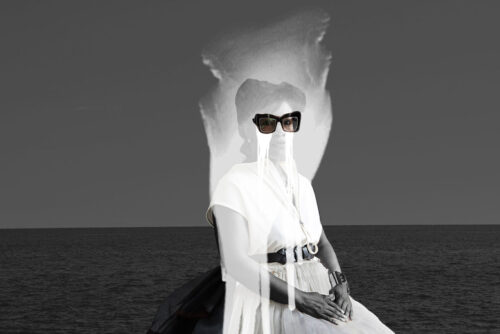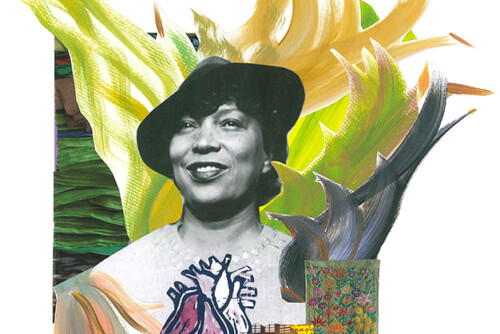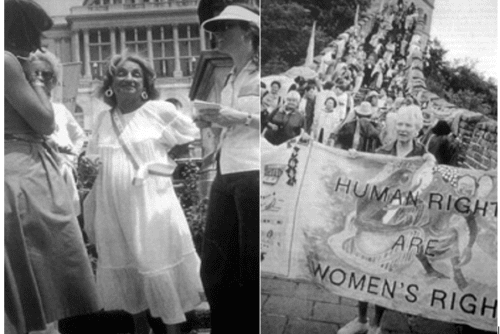And look at all the antihumani prejudice there is. A woman can be with another woman and that’s okay, but a chusma woman like you and a woman-oso humani like me, we couldn’t hold hands together or kiss in public.
—Rodesia to Carmelita in Chicas 2000The world we live in today, the cradle of our modern civilization rose from mountains of plastics in the Pacific. Mountains that were indestructible, that could sustain natural and man made disaster, war, tsunamis. That plastic is the very foundation of our civilization.
—CEO, Post Plastica
Alina and Ela Troyano write, perform, act, direct, make films and performance pieces, consult, create, and practice at the intersection of feminism, queer theory, and race studies—and so much more. They are biological sisters and longtime collaborators. Ela Troyano, a protégé of Jack Smith, is the award-winning film director of Carmelita Tropicana: Your Kunst is your Waffen (1994); Latin Boys Go to Hell (1998); and La Lupe Queen of Latin Soul, a documentary broadcast in June 2007, on the PBS series Independent Lens. She has also directed TV series (Reyes y Rey and Angeles for Telemundo/Sony 1998-99) and theater (the critically acclaimed A to B by Ricardo Bracho at INTAR 2002). Together with Uzi Parnes, in the 1980s, Alina and Ela collaborated in the creation of Carmelita Tropicana, Alina Troyano’s bio-performative alter, whom she lives, writes, and performs as.
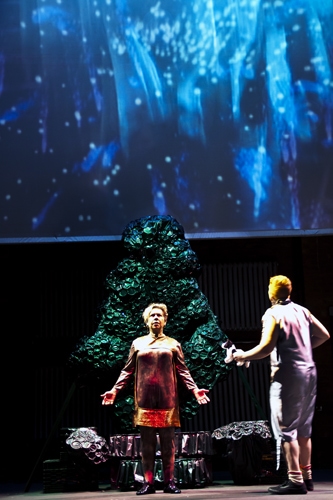
Carmelita does stand up; drag (as Pingalito Betancourt); manifesto; radio; song; dance; theater; performance; installation; and film. She writes or collaborates on her material, including Memorias de la Revolucion/Memories of the Revolution (1986, with Uzi Parnes); Milk of Amnesia/Leche de Amnesia (1994); Sor Juana: The Nightmare (2000, with Ela Troyano); Your Kunst is Your Waffen (with Ela Troyano); and The Conquest of Mexico as Seen through the Eyes of Hernan Cortes Horse (with Uzi Parnes).
In this interview, we discuss two of Carmelita Tropicana’s performance pieces concerned with futurity and biotechnology—Chicas 2000 (1997) and Post Plastica (2013), the latter co-written and directed by Ela Troyano. Chicas 2000 takes place in 1999, 2013, and 2014. It opens with Carmelita Tropicana, a nightclub entertainer, taping her cable variety show. The police show up, arrest her, and send her to the DNA Remodeling Agency and Behavior Modification Unit (BMU) because she has the chusma gene. This gene “gives rise to a disease known as chusmeria—shameless, loud, tacky behavior,” and the government has stepped up its efforts to combat it.1 The nefarious Dr. Igor bails Carmelita out, restrains her and subjects her buttocks to a nonconsexual cloning act that results in clones Clana and Cluna. Carmelita is rearrested, separated from her clones, and subject to behavior modification treatments for, among other things, Table Manners and Grammar and Syntax Correction to weed out her chusmeria. There, she meets, has an affair, and escapes with Rodesia, an oso-woman. She seeks out her clones, who have also escaped from BMUs, in the Free Zone.
Post Plastica takes place in 2013 and 3000. Carmelita plays Ho, an artist and mentor to Plastica, a wannabe art star; she discovers that Plastica has stolen her ideas through a podcast she sees on her computer. In a rage, she copies and performs online an experiment she sees where Coke and Mentos are combined to explosive effect; she adds in injections of Botox to make an Extreme Art performance on YO Tube, getting more than 7 million views. She blacks out. The next scene is set in the year 3000, where Ho is kept, preserved, and studied as an Ancient Female. Inanimate and comatose, she is in the care of Ursa, a hybrid she-bear, who monitors Ho’s thoughts on a screen over the beehive-like pedestal in the lab where Ho is maintained in life suspension.
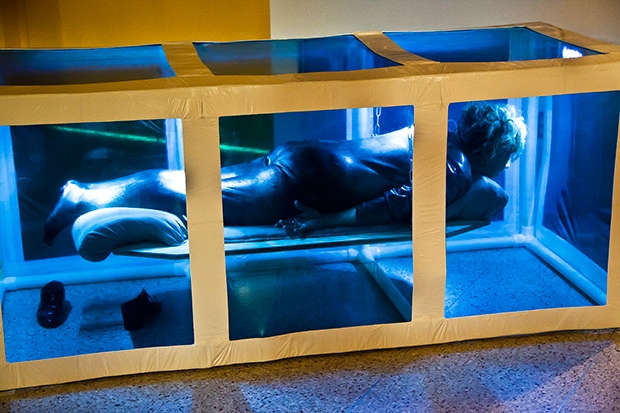
Ursa’s efforts to awaken Ho finally pay off and Ho discovers that habitable land is now the highlands, a continent of plastic, ruled not by a president but a female CEO, both holographic and flesh-and-blood, who controls everyone and everything save for the underground. The CEO speaks and broadcasts empty political platitudes, celebrating the distillation of thinking to organizational aims. Ho’s screen memories, of Arab Spring, Obama, Occupy, polar bears, and Topsy the Elephant, electrocuted by Edison, confound the CEO, who freezes and mutes her. Ho and Ursa become lovers and escape to the underground where bees are sacred insects and rebels exist outside the CEO’s control. The CEO finds and arrests Ho and Ursa, killing them. The play ends back in 2013 with Plastica escorting the audience to an installation featuring Ho, preserved in a glass tank, in the manner of the tiger shark in Damien Hirst’s The Physical Impossibility of Death in the Mind of Someone Living.
In both Chicas 2000 and Post Plastica, futurity and biotechnology emerge as key issues in relation to companion and cross species, sexuality, race, imperialism, and the persistence of plastic. I talked with Carmelita Tropicana and Ela Troyano about these performances over two conversations, one on the telephone and one in person in New York City, in May 2013.
Kathleen: Why Chicas 2000 (1997), why that title and project?
Carmelita: Chicas 2000. I got a booking before the play was written, a commission by Dixon Place for the Toyota Comedy Festival, so it had to be a comedy. This was in 1997 and the millennium was approaching. Both Ela and José Muñoz wanted me to work with two younger performers, Anna Margaret Sanchez and Rebecca Sumner Burgos. These are girls, chicas, and the title had to be appealing. It had to be funny, sexy with a little Latino flavor, a combo for a hybrid Latino and Anglo audience.
With the millennium approaching, what could be a more delightfully sounding title to grab an audience than Chicas 2000? That’s how that came about. I had the title, I had the actors, and then I had to write it.
Ela: Carmelita thought it would be really funny if the far-off, distant future, instead of being a thousand years from now, was really next year, in 2000. Chicas 2000.
Carmelita: That was ’97, and I was dealing with the future. Back then, the future was going to be 2013 and 2014. And we’re doing this now.
Kathleen: What is your interest in plastic? Carmelita loves plastic in Chicas 2000, and then you have a character named “Plastica” in Post Plastica.
Carmelita: In Chicas 2000, I was trying to use the concept of chusma, a derogatory word used by Latinos to refer to the lower classes. It’s a word included in the glossary of the program notes for Chicas. It means loud, gross, tacky, excessive behavior, tasteless with attitude—the equivalent to white trash, the people-of-color trash.
And in this case, it was the chusma, Latinos, people-of-color trash, who carry the chusma gene. And as such, chusmas are drawn to plastics—plastic flowers, tight outfits made out of spandex [see photo below] and instead of leather we have pleather. That was what I was thinking about in terms of plastics in Chicas.
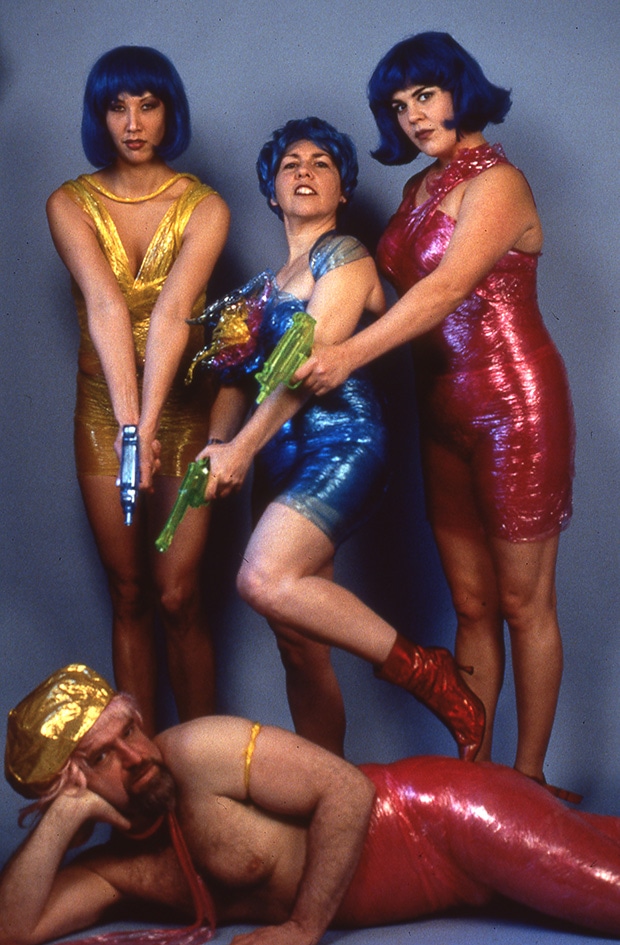
Ela: And Post Plastica refers to Ho’s life after breaking up with her ex Plastica—Ho’s life post her protégé/lover Plastica.
When we were writing the piece, I went to see a talk by Margaret Wertheim of the Institute for Figuring. She works with her twin sister, Christine, and they curate exhibits on scientific and mathematical themes. Margaret was beginning a huge art and science project, The Hyperbolic Barrier Reef, where they asked people around the world to crochet coral reefs and to contribute their crocheted pieces for a huge exhibit at the Smithsonian. Bjork crocheted a piece. Margaret was trying to garner attention, to explain the damage we were causing with our consumption of plastics. She had photos of these huge islands, about the size of Texas, made of plastic garbage floating in the North Pacific Ocean. I had never heard of this and came back talking about the islands of plastic I had just seen in the photos. And Carmelita said, “I’ve got it. Let’s call her Plastica!” Ho renames her cunning lover/protégé Plastica.
And we both cracked up because the idea of Plastica as one of the characters was great. And later on the CEO explains their civilization is born from these islands.
Carmelita: Another reading of plastica is that in Spanish when we say “no seas plastica,” we mean, “don’t be vapid, don’t be a surface person, involved only with the image, material values, rather than the real core of something.” Someone concerned with image, more with hair-do than thinking—not that they are mutually exclusive. That was a reading of the word plastics. We like to pick terms with multiple meanings and people can read it any way they want. And then post is a term that refers to time and used in art as in postmodern, and that also was appropriate.
Kathleen: So Chicas is set a couple of years, and Post Plastica a millennium in the future. What does starting in the present and then jumping to the future, whether the near or the distant future, allow you to do?
Carmelita: There are differences. Chicas aims at a class and ethnic critique and what it means to be a person of color in 1997. It targets race and ethnicity nationally and locally in New York City. I was dealing with chusma, a Latino concept. And I was trying to make an Anglo audience reflect on the term and their perception of Latinos.
I was referencing race and class and what was happening in New York City’s Lower East Side with gentrification. We have Chusma Town, the ghetto where Latinos or people of color live and the Chusmatic Casino, where the higher classes go when they want to go slumming. And there I talk about the Bowery changing and transforming a fancy Bouvier Boulevard. The Bowery is not Bouvier Boulevard.
However, the Bowery in the 1990s used to be full of homeless people and alcoholics. Now it has become a very respectable, gentrified area that houses the New Museum along with Whole Foods and trendy hotels.
Ela: I had nothing to do with Chicas; at the time Uzi Parnes was working with Carmelita. But I thought the storyline was really interesting, and the characters were incredible. It made no sense to me to drop these ideas or to not to produce the work again.
At some point we decided to work on a film script and we began developing ideas and characters from Chicas. And this evolved into Post Plastica.
Carmelita: We both wanted to keep working with the woman-bear character and reinvent others. The story would begin in present time and the critique and the satire have to do with the commercialization of art, age discrimination, and the global use and misuse of technology.
- Alina Troyano, with Ela Troyano and Uzi Parnes, I, Carmelita Tropicana: Performing Between Cultures, ed. Chon A. Noriega, (Boston: Beacon Press, 2000): 77. [↩]


